

Case Study: Computers in diving and marine exploration, featuring RuggON LUNA3
Emerging opportunities and synergies between rugged mobile computing and drones/unmanned mission technologies
Gearing up for the coming logistics revolution
Rugged tablets help secure borders
Ruggedness. Quality. Leading edge design
Rapid field service deployment with RuggON PX-501
RuggON PM-522 supporting a new era of marathon
RuggON PM-511 helps
create smarter assembly lines
Le Blé d'Or Brewery in Taipei relies on RuggON PM-521 rugged tablet to provide factory management
RuggON PM-511 rugged tablet helps increase hospital collaboration in Israel
|

|

|
|
RuggON SOL PA501
Finally a powerful, versatile rugged Android tablet that's as quick and responsive as a modern smartphone
By Conrad H. Blickenstorfer; photography by Carol Cotton
Taiwan-based RuggON Corporation's SOL PA501 is a rugged, modern, durable tablet, running Android 9 "Pie" on a powerful octa-core Qualcomm Snapdragon 660 chip. RuggON, based in Taiwan, makes some of the best rugged tablets available anywhere, as well as a series of equally impressive vehicle-mount computers. If the SOL PA501, introduced in mid-2019 looks familiar, it's because the newcomer is based on a rugged tablet platform that has, running Microsoft Windows, proven itself in the field for a number of years. This new version of the tablet is for those who seek a state-of-the-art Android version of the platform.
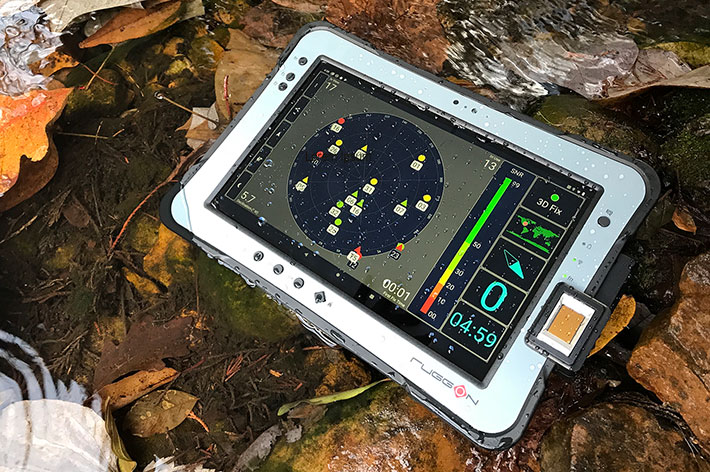
The addition of the SOL PA501 means that RuggON's 10-inch line is now one of the very few rugged tablet platforms available both with Android and with Windows, the latter at different levels of performance. The PX501 (Intel Core) and PM-521 (Intel Atom) are on the Windows side, the SOL PA501 on the Android side, all with the same dimensions and designed to use many of the same peripherals, docks and accessories.
Rugged Android tablets 2.0
Android has had a peculiar history in tablets. We're living in a world where the desktop remains dominated by Microsoft whereas smartphones are dominated by Android, with Apple having its customary proprietary high-end presence in both. But whereas Android scored a knock-out punch over Microsoft in smartphones and — the high-end iPhone notwithstanding — dominates the smartphone market, the situation is much less clear in tablets. Sure, the iPad instantly established tablets as a game-changing platform right from its launch in 2010, and rugged Android tablets appeared shortly thereafter, but they weren't nearly as successful as expected.
Why did Android tablets struggle when Android phones did so well? Perhaps it was because, unlike phones, tablets were viewed as desktop extensions. Perhaps Google's almost exclusive focus on phones kept tablet buyers away. As a result, many early Android tablets were timid attempts  that failed to get traction. They were seen as junior partners to their Windows-based siblings, something not as useful and powerful as Windows tablets. that failed to get traction. They were seen as junior partners to their Windows-based siblings, something not as useful and powerful as Windows tablets.
The situation is changing now and there is a veritable flood of excellent new Android handheld hardware. Android itself is growing up and is becoming much better suited for corporate and industrial use. Add to that the almost universal user familiarity with Android, and there's now a significantly stronger business case for Android tablets.
That said, Android on rugged tablets remains a platform in flux. On the one hand, Android is literally used by billions, making for a huge developer community, furiously advancing hardware and software, and a work force that needs little or no training with Android. On the other hand, rapid progress means rapid obsolescence, there's vexing version fragmentation, upgrading from one version of the Android OS to the next is rarely guaranteed, and Google is exerting an increasingly heavy hand on the platform.
The genesis of SOL
Overall, RuggON's launch of this new Android-based SOL PA501 tablet is an indication of growing interest in strong, competent Android tablets for industry and enterprise. The existing Rextorm platform was perfect for a new push into Android. And whereas early Android tablets often felt a bit sluggish, new SOL PA501 packs a punch. It's using the same octa-core Qualcomm Snapdragon 660 that powers many premium brand high-end phones. That makes it far more powerful than older rugged Android tablets, and more efficient as well.
As for size, the SOL PA501 measures 11.0 x 7.7 inches, just like the Windows-based PX501. Put in consumer tablet perspective, it's larger than a standard iPad's 9.8 x 6.8 inches and a bit smaller than the latest 12.9-inch iPad Pro's 11 x 8.5 inches. As a fully rugged device the SOL PA501 is quite a bit thicker than an iPad, 0.9 inches. And as far as weight goes, the SOL PA501 tips the scale at just a bit over three pounds.
The image below shows the RuggON SOL PA501 from the front and from all four sides.
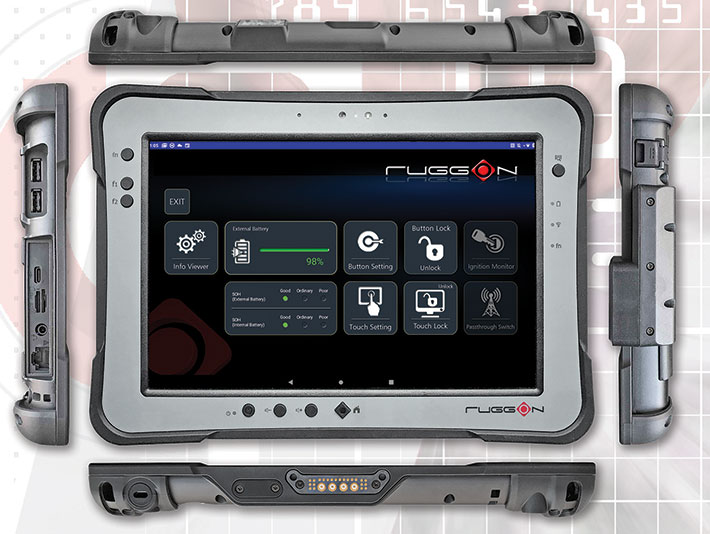
The overall look of the tablet is dominated by the light-gray bezel that extends 3/4 of an inch beyond the thin black plastic frame of the actual display, and is then contained within a quarter inch of tough rubber molding. The design is accentuated by a slight "Coke bottle" concave indentation on all four sides, adding both protection, grip, and elegance.
Controls and annunciator lights are all on the front of the tablet where they can be seen easily. There are two shiftable, programmable function buttons on the left; a barcode trigger and lights for charge, WiFi and Function on the right; webcam, microphones and light sensor on top; and power, volume up/down and the Android Home key on the bottom. The areas where palm and thumbs rest when holding the tablet are kept clear.
Going around the tablet, on the left side is most of the I/O, sitting behind two a protective rubber plug covers. Standard, on the right side are the power plug and a DB9 RS232 (our review unit came in an optional fingerprint reader configuration). Along the bottom is a Kensington lock slot, an optional dual antenna pass-through for installed wireless functionality, and the tablet's 26-pin surface mount docking connector. The top is unadorned with the exception of small bulge/window that can be used for the optional barcode reader.

The image above shows the left side of the SOL PA501. For illustration purposes we took both protective cover doors off. From left to right, there are:
- two USB 2.0 Type A ports (in lieu of the heat exchanger for the Windows version's fan).
- a USB 3.1 Type-C port
- a micro-SIM slot
- a micro-SD card slot
- a 3.5mm headphone/speaker jack
- an RJ45 Ethernet jack

The image above shows the right side of the SOL PA501 with the optional screw-on fingerprint reader installed. Without this option, this is where the standard RS232 DB9 serial (or an optional USB 2.0 port) port would be.
How does the Android SOL PA501 compare to the Windows PX501?
When there are two computers that look the same but are different inside and use a different operating system, how do you compare them? How do you decide which one is better, or better suited for your application? And on the manufacturers' side, which platform should you support, and how should you go about it?
There are no simple answers. Microsoft has completely dominated the desktop and laptop market for almost four decades. Microsoft also dominates IT, and there is an incredible wealth of software that runs on Windows, including most of the truly complex systems. Android, on the other hand, dominates the massive smartphone market and there's a massive number of Android apps.
|
RuggON SOL PA501 vs PX501
|
|
|
Model
|
SOL PA501
|
PX501
|
|
|
Processor
|
Qualcomm Snapdragon 660
|
Core i7-7300U or i7-8250U
|
|
RAM
|
3GB LPDDR4
|
8-16GB DDR4
|
|
Storage
|
32GB eMMC
|
128GB or 256GB M.2 SSD
|
|
Fan
|
No
|
Yes
|
|
OS
|
Android 9.0
|
Windows 10 IoT Enterprise
|
|
Display
|
10.1" (1920x1200)
|
10.1" (1920x1200)
|
|
Interface
|
Capacitive multi-touch
|
Capacitive multi-touch
|
|
Active digitizer
|
No
|
Optional
|
|
Cameras (front/rear)
|
8mp/13mp
|
2mp/8mp
|
|
WiFi
|
802.11ac
|
802.11ac
|
|
Bluetooth
|
Bluetooth 5.0 class 1
|
Bluetooth 4.2
|
|
Security
|
ARM Trustzone
|
TPM 2.0
|
|
Size
|
11 x 7.7 x 0.9 inches
|
11 x 7.7 x 0.9 inches
|
|
Weight
|
3.1 pounds
|
3.0 pounds
|
|
Battery
|
48.6 whr, optional 97.2 whr
|
48.6 whr, optional 97.2 whr
|
|
Fast charge support
|
Yes
|
Yes
|
|
4G LTE
|
Yes
|
optional
|
|
NFC
|
Optional
|
Optional
|
|
1D/2D barcode
|
Optional
|
Optional
|
|
UHF RFID
|
No
|
Optional
|
|
USB 3.1 Type A
|
No
|
Yes
|
|
USB 3.1 Type C
|
Yes
|
Yes
|
|
SIM
|
2 x Micro SIM
|
1 x Micro SIM
|
|
HDMI
|
No
|
1 x Micro HDMI
|
In tablets, however, no one truly dominates. Apple, Android, and Microsoft are all represented. And that is why it makes sense to offer specialized devices, such as rugged tablets, both in Windows and Android versions. It makes sense, but it's not easy. One must predict the market and demand. And the cost of supporting two OS platforms is high.
Historically, vendors have tried to run Windows and OS on essentially the same hardware with the same processor. That wasn't very successful, because it made Android versions, in essence, run in emulation.
When RuggON was faced with how to go about supporting both OS platforms, they saw no need to reinvent their very popular 501 Series tablet hardware platform. But they were also faced with the fact that Android could not run on the Intel processors powering the Windows versions.
So they decided to use as much of the 501 Series hardware as possible, but invest in state-of-the-art electronics developed just for Android. The table to the left shows what's the same in the Android and the Windows version, and where the two differ.
As you peruse the table, keep in mind that the Intel X86 architecture is very different in many ways from the ARM architecture that's used by Android. Windows systems are usually very modular, offering lots of expansion and many different configurations right on the motherboard. ARM-based systems, mostly smartphones, are much smaller and therefore much more integrated. Smartphones don't need to be modular and expandable; they simply must get the job done quickly and efficiently.
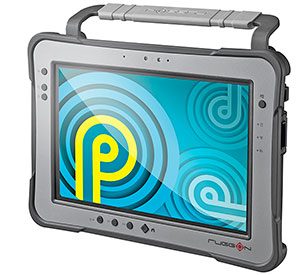 RuggON builds high-performance tablets that can handle virtually any job in the field. So on the Windows side, they use high-performance mobile processors. The same had to be true on the Android side. RuggON builds high-performance tablets that can handle virtually any job in the field. So on the Windows side, they use high-performance mobile processors. The same had to be true on the Android side.
They selected the Qualcomm Snapdragon 660, which was designed to pack the punch smartphone customers required from a high-end phone into a highly integrated module.
Technological advances are even faster on the ARM/Android side than they are on the Windows side, and so the Snapdragon 660 is no longer totally new, but it's a newer and faster platform than almost anything else used in rugged Android tablets and handhelds.
Some differences in the specs are due to the very nature of the platforms. ARM generally needs less RAM and less storage than Intel. Android has better camera support, hence the PA501's much higher resolution cameras. Being essentially a phone platform, Android devices usually have dual SIM card slots. RuggON implemented the dual SIM feature on the PA501. The first SIM slot is hot-swappable, and there can be dual SIM dual standby for sending and receiving data.
Another interesting Android feature implemented on the PA501 is over-the-air updating via RuggON's own RuggOTA software. This can be used to wirelessly update the entire system image and RuggON also provides MCU (MicroController Unit) firmware upgrades that way. And as of early 2020, RuggON offers RMDM (RuggON Mobile Device Management) for remote installation, update, and removal of apps by group and schedule.
How did RuggON manage to provide the inherent functionality their industrial and vertical market customers require, like a barcode scanner? Those are available on both platforms, either integrated (like the barcode scanner) or via bolt-on modules (like the fingerprint reader).
What's inside the RuggON SOL PA501?
For the past several years, designers of rugged tablets have been facing a difficult assignment. They must create a device that looks sleek and elegant enough to appeal to customers brought up on consumer tablets, but also one that's tough and rugged and has all the features needed in the field and on the job.
RuggON has done an excellent job with that, as from the front the SOL PA501 looks just like a more muscular consumer tablet. But turn it around and it's instantly clear that this machine is all business.
The pictures below show the backside of the SOL PA501, reminiscent more of a business laptop than a generic Android tablet. On the left is the backside as is, on the right with the bumpers, battery, and expansion compartment cover removed.
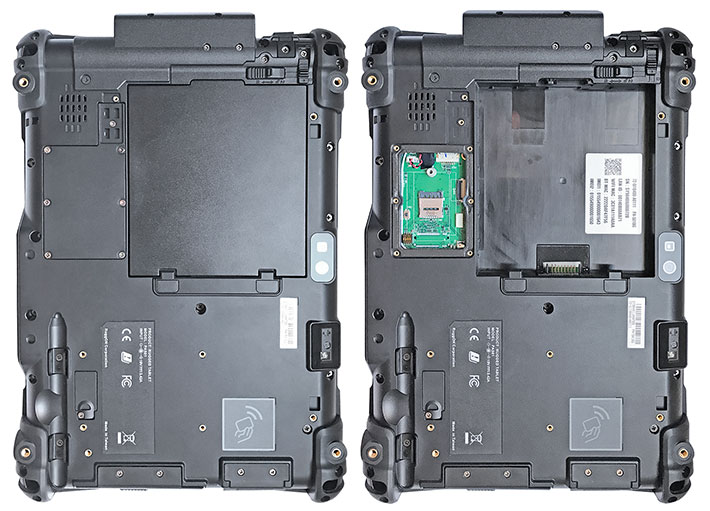
The SOL PA501's 48.6 watt-hour Li-Ion battery is square, compact, and less than half an inch thick. It fits flush into the backside of the tablet and is securely held in place via a springloaded lever that can be locked in place. The battery compartment itself is not sealed. Sealing to the interior of the device is via lips around the battery that press against a rubber patch around the battery contacts.
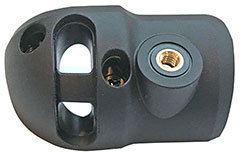 To the left of the battery, a small plastic cover, secured by seven Philips head screws and sealed via a lip-and-pressure seal allows access to the tablet's SIM card slot. To the left of the battery, a small plastic cover, secured by seven Philips head screws and sealed via a lip-and-pressure seal allows access to the tablet's SIM card slot.
The tablet's four protective bumpers are intricately formed of elastomer with a tough rubber overmolding. Each is held in place with two Philips head screws. If a bumper gets damaged, it can easily be replaced.
Some parts that are often molded into the housing in lesser tablets are removable and replaceable on the SOL PA501. That includes the protective port covers and the rubber plug of the power jack. If these gets damaged, they can easily be replaced.
Unlike the Windows-based RuggON PX501 that has a fan exhaust, the Android-based SOL PA501 doesn't need a cooling fan. There are slots for the tablet's speaker, but the speaker is a self-contained sealed unit, so no water will go through the speaker slots into the interior of the tablet.
In terms of overall construction, the SOL PA501 consists of three layers. There's the ABS plastic front plate/bezel. Fastened to that is the tablet's very tough magnesium chassis that has the display mounted on one side of it and the motherboard and ancillary electronics on the other. And then there's the black ABS plastic back cover that's secured to the front side with a good two dozen Philips head screws of different sizes. Sealing around the perimeter is via a tongue-and-groove design that does not seem to rely on an o-ring in the groove. One suggestion we'd have for RuggON is to either use the same type of screws all around, or to make the screws different enough so they can be told apart. As is, some have delicate little rubber rings that easily get stuck or vanish, whereas others do not. Another solution would be to design the case so that screw holes are technically outside the tongue-and-groove sealed inner part of the tablet
Once all of the screws are loosened, gently prying the two sides apart allows separating them without having to undo any additional snaps or latches. There is just one wire assemblies between the two sides, that for the speaker.
Compared to a consumer mass-market product like the iPad with all of its super-miniaturized electronics concentrated into a couple of tiny circuit strips, the SOL PA501 is fairly complex inside, albeit with significantly fewer modules, connectors, components, and other assorted parts than its Windows-based PX501 cousin. As is always the case with RuggON products, everything is neatly organized. Wires aren't just hanging around; there are little metal guides individual wires fit into. We haven't seen that solution before. Black tape covers a lot of the connections, probably both to insulate the connections and also to keep them from rattling loose. That's in place of the little drops of silicone glue used in lots of devices to keep connections securely fastened. The advantage of tape and guides is that connections can be undone without having to break and scrape away glue.
The pictures below show what it looks like inside the SOL RuggON PA501:
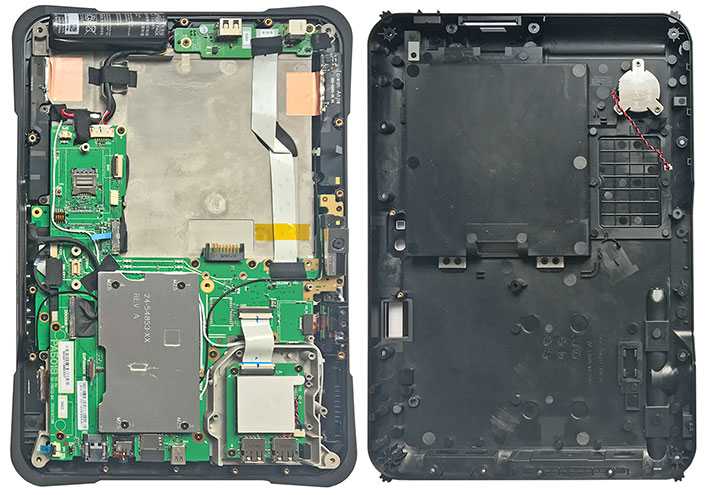
Since the Qualcomm SnapDragon processor and its ancillary electronics generate considerably less heat than the Intel Core chip in the Windows-based PX501 unit, thermal engineering of the device of the Android tablet is far simpler. There is no need for a fan that makes noise and, like all things mechanical, can get clogged or break down.
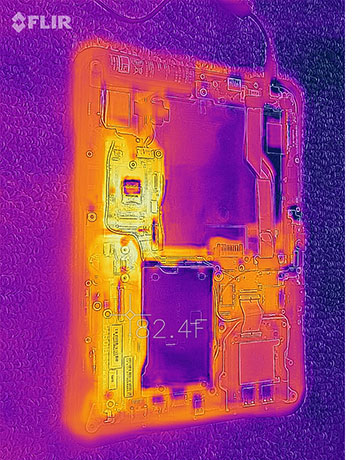 There's also no need for elaborate copper tubing to syphon heat off the CPU and transport it to the fan's heat exchanger. All the SOL PA 501 needs is a small metal heat spreader. Interestingly, the Android tablet's magnesium frame, which carries over from the Windows version of the tablet, still has the fan compartment, but in the SOL PA501 it's repurposed to house a couple of extra USB Type A ports. There's also no need for elaborate copper tubing to syphon heat off the CPU and transport it to the fan's heat exchanger. All the SOL PA 501 needs is a small metal heat spreader. Interestingly, the Android tablet's magnesium frame, which carries over from the Windows version of the tablet, still has the fan compartment, but in the SOL PA501 it's repurposed to house a couple of extra USB Type A ports.
In terms of modules, the Android version of RuggON's flagship tablet needs far fewer than the Windows model. Almost everything is integrated into the unit's MS-01 PRO System-On-Module that includes Wi-Fi, Bluetooth, and even the Qualcomm Snapdragon SDM660 chip.
The image to the left shows the thermal footprint of the SOL PA501. The infrared picture, taken with our lab's FLIR ONE Pro thermal imaging camera, shows the heat generating components of the design, and how very effectively the metal heat exchanger with its large surface area spreads and dissipates the heat.
Like the Windows tablet, the Android-based SOL PA501 has both edge-mount connectors as well as a separate remote I/O daughterboard that in our unit housed the power jack and a Type A USB port.
So far I have referred to the housing of the SOL PA501 as "plastic." But not all plastics are equal. What RuggON is using is PC+ABS-FR(40)<94V0. PC+ABS stands for PolyCarbonate + Acrylonitrile Butadiene Styrene, which is an alloy that combines the strength of polycarbonates with the high abuse resistance of ABS. FR means it's a Flame Retardant material, and <94V0 refers to the UL 94 standard for flammability safety for plastic materials, with V0 meaning that in a test, a vertically held sliver of that material stops burning after 10 seconds, with no burning drips. This is good stuff RuggON is using to build its tablets.
Also of note is the substantial 7 watt-hour bridge battery that makes the main battery hot-swappable. Unlike most backup batteries that only provide a few minutes of run time, the one in this tablet can easily handle even a lengthy main battery interruption.
The SOL PA501's standard battery packs 48.6 watt-hour. For those who need more, we recommend the optional 97.2 watt-hour battery (the larger battery in the picture above to the right) that adds a bulge and some weight, but is really a better match for the high-powered chip. Also of note: the battery supports fast charging.
Our evaluation unit came with the optional integrated 1D/2D barcode reader. The scanner window is molded into the housing and the scanner mount bracket is part of every SOL PA501 as well.
The image compilation below shows some of the details of the RuggON SOL PA501. On the left is a closer look at the SIM slot that sits inside the tablet underneath an access cover. On the right is the unusually powerful 7 watt-hour backup battery that makes hot-swapping of main batteries easy.

Below on the left is a closer look at the tablet's optional 1D/2D barcode reader on the left and the 13mp documentation camera with its LED flash on the right.

Excellent performance
What about performance? There, comparison is more difficult because benchmark programs are usually CPU architecture-specific. We have been running benchmarks on Android devices for years, but our sample is much smaller than that of Windows-based devices.
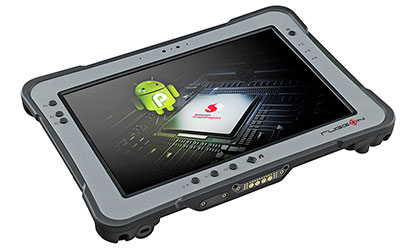 That said, we did run AnTuTu, Vellamo, and PassMark Mobile on the SOL PA501, and the SOL PA501 is MUCH faster than any other rugged Android device we've tested, generally twice as quick overall as other recent devices we've had in the lab, and four times faster overall than earlier systems. The only device that came close to the SOL PA501 was a late model Huawei smartphone. That said, we did run AnTuTu, Vellamo, and PassMark Mobile on the SOL PA501, and the SOL PA501 is MUCH faster than any other rugged Android device we've tested, generally twice as quick overall as other recent devices we've had in the lab, and four times faster overall than earlier systems. The only device that came close to the SOL PA501 was a late model Huawei smartphone.
What that all means is that the SOL PA501 is as quick and responsive as a modern smartphone, which is precisely what today's customers want.
For those interested: the benchmark results were: AnTuTu v8.0.4: 162,015. Vellamo Metal: 2,858. Vellamo Multicore: 3,840. Vellamo Browser: 5,921. PassMark Mobile: 10,011.
Battery life
Back in the dawn of mobile computing, laptops and tablets had very limited battery life. Sometimes less than an hour, and if a device managed three hours it was exceptional. Needless to say, such dismal battery life greatly limited the usefulness of mobile technology for use in the field. Battery technology has improved, albeit nowhere near as quickly as chip technology, and things are much better now.
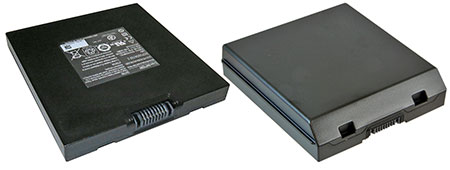 In 2010, the original iPad pretty much redefined expectations of how long a mobile device had to last on a charge in order to be truly useful: 10 hours. That's a full shift of use, plus another 25% to cover eventualities. RuggON claims "up to 13 hours" of battery life for the SOL PA501 spec sheet exceeds that number. In 2010, the original iPad pretty much redefined expectations of how long a mobile device had to last on a charge in order to be truly useful: 10 hours. That's a full shift of use, plus another 25% to cover eventualities. RuggON claims "up to 13 hours" of battery life for the SOL PA501 spec sheet exceeds that number.
Shown on the right are the standard 48.6 watt-hour battery and the optionally available extended battery with twice the capacity.
Battery life, of course, is a bit like gas mileage. It depends on the design of the vehicle and also where and how it's being driven. It's the same for a mobile computer. Battery life depends on how the computer is being used, how much work it has to do, what the backlight setting is, and so on. The only way to get any idea of how long a device will run on a charge is by using the exact same battery drawdown benchmark software and clearly establishing and describing the test conditions. On Windows-based systems we do that with PassMark's BatMon utility.
BatMon isn't available for Android, and so we used PC Mark for Android's Work 2.0 Battery Life test instead. It's a very tough test that has the device performing all sorts of work continuously, until the battery is out of charge. Work includes browsing, video editing, writing, photo editing, and data manipulation. The SOL PA501 clocked in at 8 hours and 17 minutes. The graph below shows that the SOL P501 completed 50 work cycles, with steady performance and only a slight increase in temperature during the entire test.
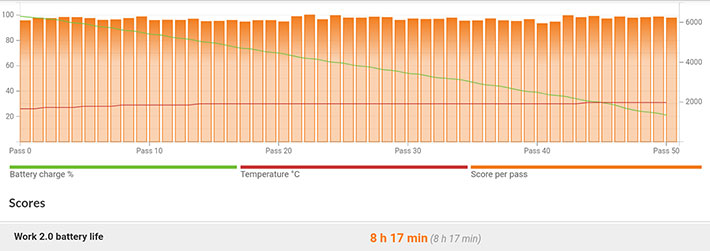
Why the discrepancy between our tested 8 hours and 17 minutes and RuggON's claim of up to 13 hours? Probably because of the testing method. Our test assumed that the tablet would run on battery the entire shift, always doing work. In real life, most systems spend at least part of a work day idling or asleep.
In a separate test we monitored the SOL PA501's actual power draw. With the backlight at about 50%, we saw a draw of 4.7 watts. Dividing the standard battery's 48.6 watt-hours by 4.7 watts equals 10.34 hours. With display backlight at full bright power draw went up quite bit, so keep that in mind when working outdoors in sunlight.
That said, between the availability of the optional 97 watt-hour extended battery and the SOL PA501's internal backup battery that provides both a "reserve tank" for another hour or so as well as enabling hot-swapping of batteries, PA501 users will rarely encounter battery life issues.

Bright, sharp 10-point procap multi-touch display
Unlike just a few years ago, virtually all brand name tablets have good displays these days: sharp, bright and usable both indoors and outdoors. Even most of today's consumer tablets remain viewable outdoors. Premium tablets generally have strong backlights. And most displays offer the perfect viewing angles from all directions that we consider mandatory in a tablet. What do we expect from a rugged tablet like the RuggON SOL PA501?
Rugged tablet computers will be used outdoors and that includes bright, direct sunlight. Standard transmissive LCD displays, however, wash out in daylight, and that's why over the past few years, sunlight-readability has become a major selling point in the rugged tablet market.
 The current approach to making displays usable outdoors is a combination of strong backlight, anti-reflective coatings, linear and circular polarizers, and direct bonding of as many of the LCD assembly's layers as possible. The current approach to making displays usable outdoors is a combination of strong backlight, anti-reflective coatings, linear and circular polarizers, and direct bonding of as many of the LCD assembly's layers as possible.
All the major players in the rugged/outdoor arena use those technologies, and the difference between approaches boils down to the presence and extent of those expensive optical coatings, how they are applied, how the various layers are bonded, and backlight brightness.
As far as backlight brightness goes, the table to the right shows our measurements of the light emitted by the PA501A's display. The light emitted by a display backlight is given in a unit called candela per meter squared, or cd/m2, usually just called "nits." Standard laptops generate about 200 nits. A good tablet or smartphone between 500 and 600 nits. Rugged laptops with their big batteries can generate as much as 1,500 nits. The 810 nits we measured on our review unit qualifies the PA501 as one of the brighter rugged tablets available today.
In some situations equally as important: the PA501 can be put in stealth mode with the push of a button. Then, luminance is just 1 nit, and stealth mode also turns off all LEDs, sound and RF.
Measuring 10.1 inches diagonally, the display offers 1920 x 1200 pixel resolution. This makes for the 16 : 10 aspect ratio that to many eyes is just about perfect, not too boxy and not too wide. 1920 x 1200 means 2.3 million pixels overall and 224 pixels per inch (ppi). That's plenty sharp enough for almost any kind of work.
Outside, the SOL PA501's display works well. It is bright enough to be usable under pretty much any lighting condition. Viewing angles are perfect. There are no color, contrast or brightness shifts when viewing the tablet from an angle.
Like almost all mobile device displays these days, the PA501's is of the "glossy" variety. Glossiness makes colors pop. The flipside of the glossy, vibrant displays is reflections. That's something all smartphone and tablet users have been getting used to: hold the device so as to minimize reflections.
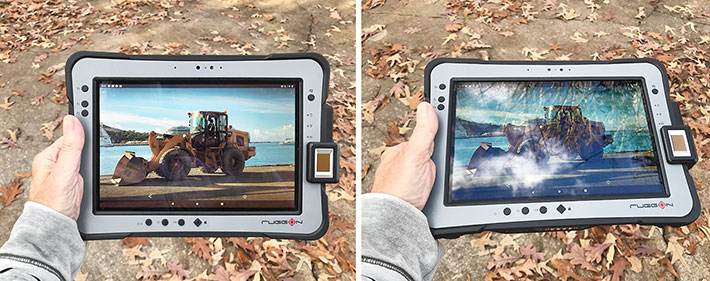
The picture below, finally, shows the RuggON tablet sitting in a cold stream in broad daylight. Even under those conditions, the display remains bright. Not just viewable, but downright brilliant.
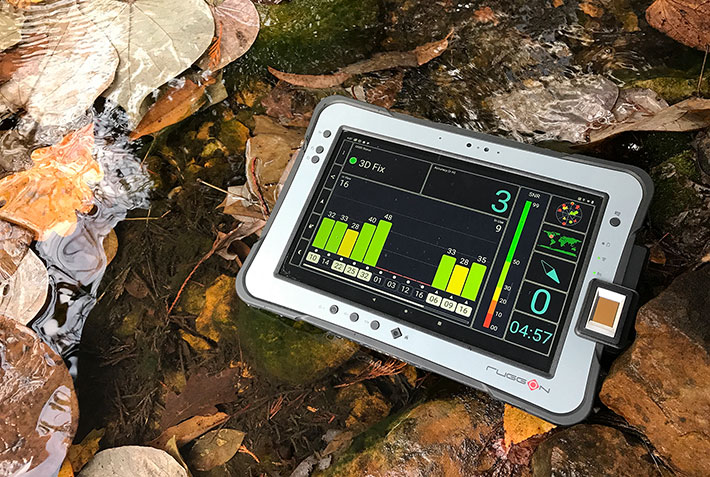
Using the RuggON SOL PA501
How does one use a big, tough Android tablet? Really very much the same as a modern Android phone. The PA501 comes with GMS, the Google Mobile Services, which means all the popular Google apps (like Gmail, Chrome, Maps, Drive, Photos, etc.) are there, as is access to the Google Play Store.
Capacitive multi-touch works as quickly and effortlessly on the PA510 tablet as users have come to expect from any smartphone and tablet these days. Capacitive touch controllers have become more sensitive over the past few years, and the one used in the RuggON PA501 can be used while wearing some types of thin gloves.
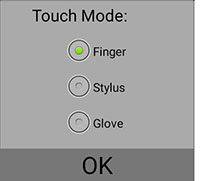 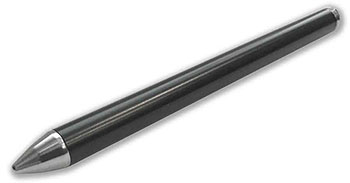 Optimizing the display for either finger, stylus or glove mode can easily be set with the Touch Mode utility. In finger and glove mode, stylus input is ignored. In stylus mode, finger touch input still works.
Optimizing the display for either finger, stylus or glove mode can easily be set with the Touch Mode utility. In finger and glove mode, stylus input is ignored. In stylus mode, finger touch input still works.
Unlike the Windows-based PX501, the PA501 does not have an active digitizer option. That's because Android was designed from the ground up for touch. There are no left and right clicks like in Windows, and no tiny icons. An active digitizer simply isn't needed with Android.
The three Android buttons (Escape, Home, Open App List) are implemented in software on the PA501. At first sight, one would expect the hardware buttons positioned below the display to fill those functions as well, but those are actually power, volume up, volume down, and Home, just like on the Windows version of the tablet.
While the primary purpose of tablets is to serve as light and handy mobile computers without the extra bulk and weight of a laptop, tablets are used in the office as well. And there it often comes in handy to use a physical keyboard instead of tapping away at the screen. Below are two ways of doing that.
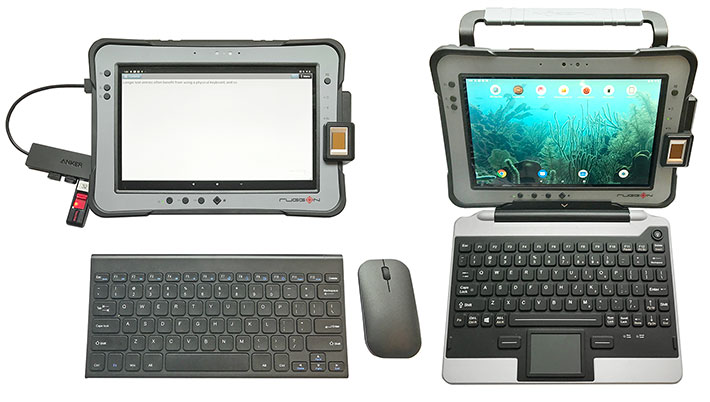
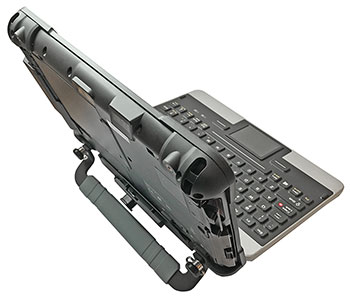 On the left above is a setup that we often use in the RuggedPCReview office. We're using a generic wireless keyboard and mouse combo and a USB port expander to plug in the keyboard/mouse wireless adapter and a USB key to copy things back and forth between the tablet and our production desktops. The PA501 has several on-board USB ports, so this setup works great. On the left above is a setup that we often use in the RuggedPCReview office. We're using a generic wireless keyboard and mouse combo and a USB port expander to plug in the keyboard/mouse wireless adapter and a USB key to copy things back and forth between the tablet and our production desktops. The PA501 has several on-board USB ports, so this setup works great.
On the right is RuggON's own RDK-501 detachable keyboard. It is fully rugged, carries IP54 sealing, has integrated backlighting with four levels of brightness, and folds like a regular laptop keyboard. It also has an integrated touchpad with left and right mouse buttons, and supports keyboard layouts in different languages.
To the right you can also see how RuggON tackled one of the principal problems of 2-in-1 setups that combine a light keyboard and a heavier tablet: how to keep it from toppling over? RuggON's solution is both simple and practical.
Their RSK-HS01 hard handle very easily screws on either the top or the bottom of the tablet. The top for carrying the tablet around, the bottom to add complete stability (and varying angles) when used with the keyboard. Brilliant!
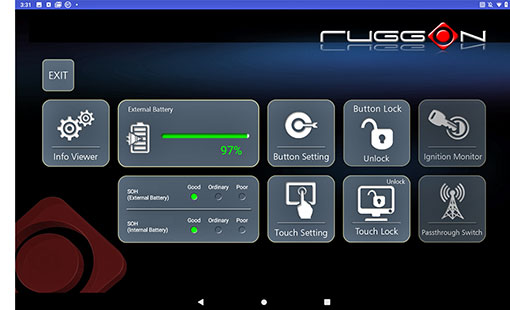 Another very useful feature of the SOL PA501 is the included DashON utility. It provides both an overview of important information (such as battery charge, settings) as well as quick access to important functions. Another very useful feature of the SOL PA501 is the included DashON utility. It provides both an overview of important information (such as battery charge, settings) as well as quick access to important functions.
Here, users can quickly change touch mode settings (finger, stylus, glove), lock and unlock the touch screen and buttons, toggle antenna passthrough between tablet and external antennas, as well as operating the ignition monitor.
The DashON utility also offers one-tap access to the button setting utility. This is where users can assign functions or features to the tablet's two function buttons, both unshifted and shifted.
Very good dual camera hardware and software
The RuggON SOL PA501 has front and rear cameras, as is standard on most modern tablets. On the front is a 8-megapixel webcam. The rear camera is for picture taking and documentation. It has an 13-megapixel imager, and the pictures we took in the highest available resolution setting came out in 4:3 aspect ratio 4,160 x 3,120 pixel resolution, almost exactly 13-megapixel. 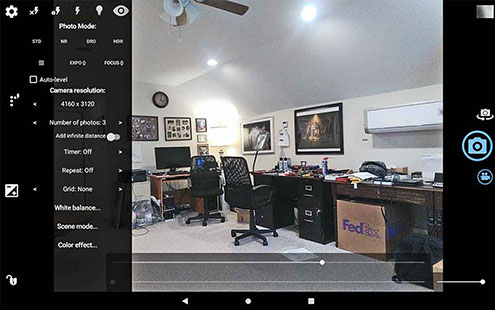 All in all, about 30 camera resolution settings are available. Images can be saved as JPEG, WebP, PNG and even RAW. Image quality can be set in 1% increments from 0 to 100%. And there are literally dozens of fairly advanced settings available. All in all, about 30 camera resolution settings are available. Images can be saved as JPEG, WebP, PNG and even RAW. Image quality can be set in 1% increments from 0 to 100%. And there are literally dozens of fairly advanced settings available.
Video settings are no less impressive. There are two dozen available video resolutions, ranging from 176x144 pixel all the way up to 4K Ultra HD with 3840 x 2160 pixel resolution. Like in photo mode, there are numerous advanced settings available. Video format can be in MPEG4 H264, MPEG4 HEVC (really H265), 3GPP and WebM; video bitrate can be set between a lowly 100kbps up to full 200Mbps; frame rate can be set, minimum and maximum video clip lengths, there's video stabilization, and lots more. For processing, the anti-banding, edge mode algorithm and noise reduction technology can all be set, and so on.
As we've repeatedly mentioned over the years, our experience with cameras integrated into rugged vertical market handhelds and tablets has generally been underwhelming, with most lagging well behind what's available in dedicated point & shoots and consumer smartphones. 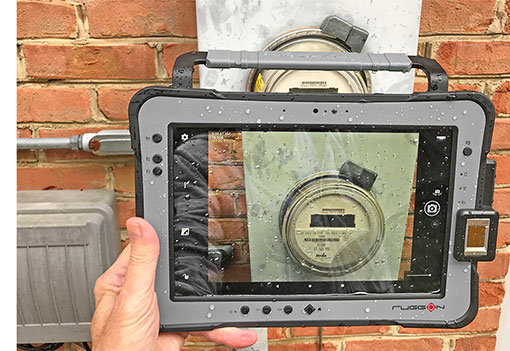 This, apparently, is one area where Android is way, way ahead of almost anything available in the Windows world, and that is amply demonstrated in the substantial difference between the camera hardware and software on the Windows-based RuggON PX501 and the Android-based PA501.
This, apparently, is one area where Android is way, way ahead of almost anything available in the Windows world, and that is amply demonstrated in the substantial difference between the camera hardware and software on the Windows-based RuggON PX501 and the Android-based PA501.
We were pleased to find that both the front- and the rear-facing cameras of the PA501 were absolutely up to the task. In picture and video taking, just like in its speed and responsiveness, the PA501 is more like a modern smartphone than a traditional tablet.
The screen snap to the right shows what the camera app looks like in picture-taking mode.
The user interface is attractive and logical. In picture taking mode, you can toggle between still and video mode, and the display is neat and uncluttered in both front and rear camera modes. However, a vast wealth of settings is always just a finger tap away.
The pictures below were shot with the RuggON SOL PA501 in 13mp mode. Click on the image to bring up a full-size version.
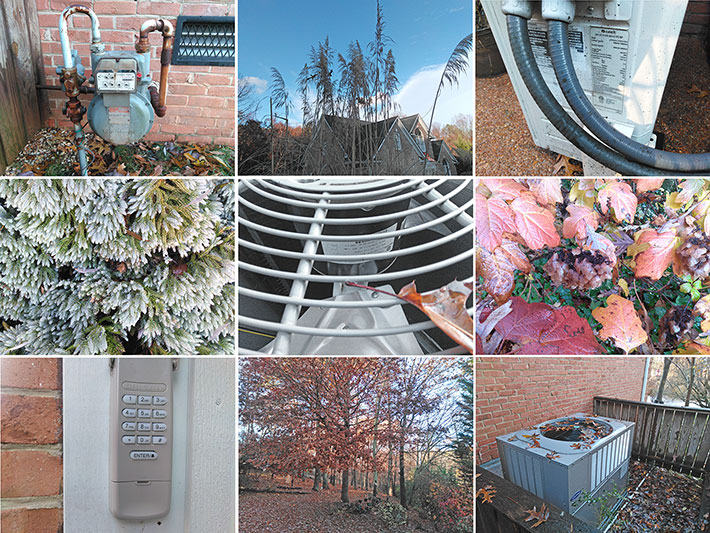
The SOL PA501 documentation camera is more than capable of taking pictures than are good enough for any job documentation purpose. In fully automatic mode there is good sharpness and image detail, and little of the massive compression that often renders pictures from such integrated cameras useless due to artifacting. A bit of a learning curve is involved when using the full gamut of available settings.
Video is way better than what we've seen from most cameras integrated into rugged devices. Being able to shoot in so many recording formats, up to full 4K, is very useful. Today's smartphones have spoiled consumers with their superb cameras and sophisticated imaging apps. RuggON made sure they won't be disappointed in the SOL PA501's imaging qualities.
Vehicle and desktop docks
One of the many things that set consumer and vertical market tablets apart is accessories and peripherals. Consumer tablet vendors usually offer a protective case and nothing else. Third parties may offer generic or custom cases, but rarely anything made for professional or industrial use. That won't do for industrial-grade tablets, and so RuggON offers both a desktop and a vehicle dock.
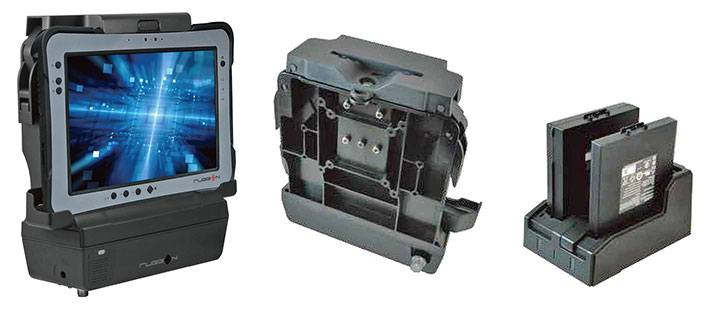
While the desktop dock is fairly basic, the vehicle dock is every bit as tough and rugged as the tablet itself. There's ignition power support, the tablet can be locked to the dock, and the dock also guards against draining vehicle power. As for features, the dock, depending on the version, provides dual USB 3.0 Type A, RS232 serial, RJ45 LAN, HDMI, VGA, audio, SMA antenna connectors as well as fused power. Antenna pass-through can be configured via the RuggON GUI utility.
For customers who intend to use the tablet in stationary locations, RuggON offers a VESA wall mount with the standard 75 x 75 mm hole pattern. This can be used with all sorts of VESA standard mounting solutions, such as those from RAM Mounts.
Tough enough for rough jobs out there
The primary reason for getting a rugged tablet instead of a lower-cost consumer solution is, well, ruggedness and reliability under duress. A rugged tablet must be able to operate in extreme temperatures, survive shock and vibration, as well as be able to withstand a variety of other environmental hazards and conditions, such as salt, altitude, solvents and cleaners, and so on. Designers of rugged computing mobile gear do this by using robust and resistant materials, physical protection mechanisms, appropriate sealing, and attention to very last detail that may affect durability.
How did RuggON address all of these issues with the SOL PA501?
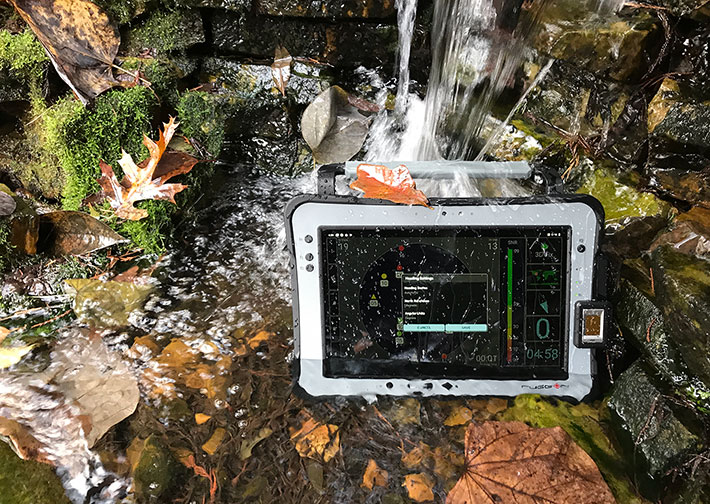
With regard to protection from the elements, the SOL PA501 carries IP65 sealing where the "6" means it's totally dustproof, and the "5" that it is also sealed against, according to the IP classification system chart, low pressure water jets from all directions. That's far better sealing that standard consumer tablets have.
That said, consumer smartphones are catching up in terms of sealing. Some are now available in IP67- and even IP68-rated versions, raising expectations. 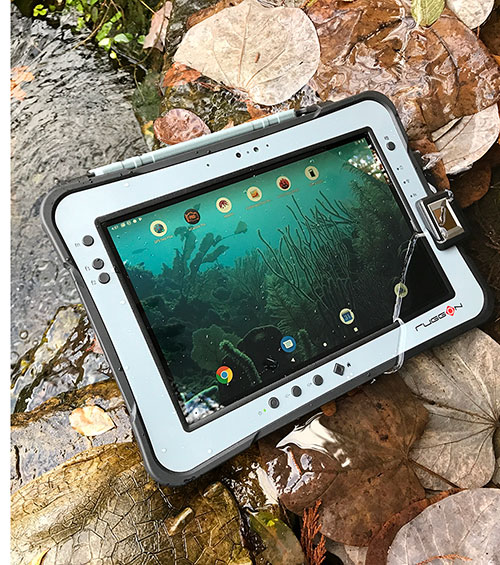 In general, it's more difficult to seal larger devices than smaller ones, and also devices with multiple ports and controls than those that have just one or two. We expect the industry to move towards almost universal IP67 protection for fully rugged devices, if not for absolute need then for the additional peace of mind. In general, it's more difficult to seal larger devices than smaller ones, and also devices with multiple ports and controls than those that have just one or two. We expect the industry to move towards almost universal IP67 protection for fully rugged devices, if not for absolute need then for the additional peace of mind.
The SOL PA501 can handle repeated drops from five feet. That's a foot more than the standard drop height in the MIL-STD-810G tests. Four feet is standard because that's the approximate distance a tablet falls when it's accidentally dropped while being used in a standing position. It's always better to exceed a standard, and the SOL PA501 does.
The stated operating temperature range of -4 to 140 degrees Fahrenheit (-20 to 60 degrees Celsius) also exceeds that of most rugged devices. This means the SOL PA501 can be used in commercial freezers as well as in hot desert climates.
The display uses Corning Gorilla Glass 3 that provides even more protection against breakage and scratching than the first two generations. That's especially important in large-screen handhelds such as the SOL PA501.
Additional display protection is provided by a display that's slightly recessed around its perimeter and then also benefits from additional protection from the corner rubber bumpers. This provides much better protection than consumer tablets where the entire front is flush glass.
Our examination of the interior construction of the SOL PA501 with its thick metal frame suggests a high degree of toughness and ability to withstand accidents and abuse. Bumpers and overall design offer ample shock absorption and there are no components that can easily rattle loose. Like any advanced rugged device, the SOL PA501 relies on multiple seals to keep dust and liquids out. These are all well designed and easy to keep in good working condition.
Overall, the RuggON SOL PA501 is right up there with the toughest and most robust devices we've tested here at RuggedPCReview.com.
Summary: RuggON SOL PA501 — a quick, tough, versatile, and ultra-rugged Android tablet for demanding applications
With their expanding line of rugged tablets, RuggON offers a superb and highly versatile hardware platform that comes both in Windows and in Android versions and with a wide range of performance. On the Windows side are the Intel Atom-based PM-521 and the 7th gen Intel Core-based PX501. On the Android side, the newly released SOL PA501 examined in this review.
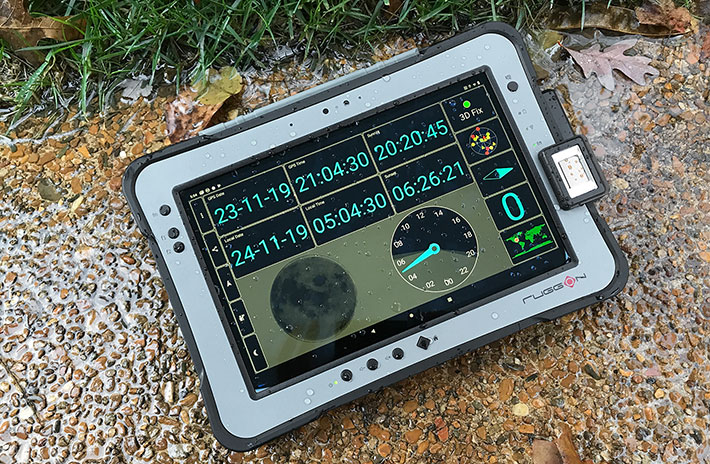
Designed as a general purpose rugged tablet, the SOL PA501 can be used for a vast variety of applications. Its sharp and bright 10.1-inch display makes it especially suitable for graphics-intense mapping and positioning deployments where precision and minute details matter. The speedy octa-core Qualcomm Snapdragon 660 processor makes for leading smartphone-class performance. There is no fan, making for silent operation. Battery life is well past one shift even with the standard. The battery is hot-swappable, and a massive 97 watt-hour extended version is available.
Great praise goes to the SOL PA501's 1920 x 1200 pixel display that's among the best we've seen. It offers perfect viewing angles from all directions, and does so without any annoying changes in hue or brightness. The Gorilla Glass-protected 10-point capacitive multi-touch screen is quick and responsive. The display can be optimized for touch, stylus or glove operation.
As elegant as the SOL PA501 looks, it's tough as nails and exudes a sense of quality and invulnerability. This tablet can survive repeated 5-foot drops, can operate in icy cold and blistering heat, and its IP65 sealing means it can easily handle dust and rain and worse.
With the SnapDragon 660-powered Rextorm SOL PA501, RuggON provides a very compelling rugged tablet solution for those who need, or prefer, Android on the job. The SOL PA501 is a modern and impressively rugged solution for all sorts of field data capture and communications deployments via a selection of add-on and snap-on modules. It will undoubtedly be of substantial interest to enterprise, industrial and vertical market customers. -- Conrad H. Blickenstorfer, December 2019
Specifications RuggON SOL PA501
| Added/changed |
Added 07/2019, full review 12/2019
|
| Type |
Fully rugged Android tablet
|
| Processor |
Octa-core Qualcomm Snapdragon 660
|
| Graphics |
Adreno 512
|
| OS |
Android 9.0 Google Mobile Services (GMS) certified
|
| RAM |
3GB LPDDR4
|
| Disk/drive |
32GB eMMC SSD
|
| Display type |
Sunlight-readable TFT with LED backlight, 800 nits luminance, water/palm rejection, Gorilla Glass 3 |
| Display size/resolution |
10.1-inch/WUXGA (1920 x 1200 pixel, 224 ppi) |
| Digitizer |
10-point projected capacitive multi-touch, glove touch |
| Keyboard/keys |
Onscreen, optional external
|
| Navigation |
Touch, stylus
|
| Card slots |
1 x Micro SDXC/SDHC card, 2 x micro SIM card
|
| Housing |
ABS plastic over magnesium chassis
|
| Size |
11.0 x 7.7 x 0.9 inches (280mm x 195mm x 23mm)
|
| Weight |
3.1 lb. (1.4kg)
|
| Operating temperature |
-4° to 140°F (-20° to 60°C) |
| Ingress protection |
IP65 (totally dustproof, sealed against low pressure water jets from all directions) |
| Humidity |
MIL-STD-810G Method 507.5 Humidity Procedure II Aggravated Cycles (Fig 507.5-7), 5 to 95% non-condensing |
| Drop |
MIL-STD-810G Method 516.6 Procedure IV, 26 5-feet drops onto plywood |
| Vibration |
MIL-STD-810G Method 514.6 Category 4, Fig 514.6C-1, Fig 514.6C-2, Fig 514.6C-3 |
| Altitude |
Est: MIL-STD-810G, Method 500.5, Procedures I & II |
| Power |
4,500mAH, 10.8V, 48.6whr Li-Polymer ("13 hours"), optional extended 9,000mAH, 10.8V, 97.2whr Li-Polymer ("up to 26 hours")
|
| Cameras |
Rear: 13-megapixel AF with LED flash, front: 8-megapixel webcam
|
| Data capture |
Optional: NFC, 2D barcode reader with OCR support, fingerprint reader |
| Sensors |
Gyroscope, G-sensor, E-compass, ambient light |
| Communication |
802.11ac WiFi, Bluetooth v5.0 Class 1, GNSS (GPS/GLONASS/BeiDou), 4G LTE WWAN |
| Interface |
1 x USB 3.1 Type-C, 2 x USB 2.0, 1 x RS232 (or USB 2.0), 1 x gigabit RJ45, audio in/out, 2 x RF passthrough, dock
|
| Price |
Inquire |
| Spec sheet |
 RuggON SOL PA501 brochure (PDF) RuggON SOL PA501 brochure (PDF)
|
| Web page |
RuggON SOL PA501 product page |
| Contact |
RuggON Corporation
4F., No. 298, Yang Guang St., NeiHu Dist.
Taipei City 11491, Taiwan
Fax: 886-2-8797-1778
Web: https://www.ruggon.com
info@ruggon.com
|
|
|
| |





 that failed to get traction. They were seen as junior partners to their Windows-based siblings, something not as useful and powerful as Windows tablets.
that failed to get traction. They were seen as junior partners to their Windows-based siblings, something not as useful and powerful as Windows tablets.



 RuggON builds high-performance tablets that can handle virtually any job in the field. So on the Windows side, they use high-performance mobile processors. The same had to be true on the Android side.
RuggON builds high-performance tablets that can handle virtually any job in the field. So on the Windows side, they use high-performance mobile processors. The same had to be true on the Android side.

 To the left of the battery, a small plastic cover, secured by seven Philips head screws and sealed via a lip-and-pressure seal allows access to the tablet's SIM card slot.
To the left of the battery, a small plastic cover, secured by seven Philips head screws and sealed via a lip-and-pressure seal allows access to the tablet's SIM card slot.

 There's also no need for elaborate copper tubing to syphon heat off the CPU and transport it to the fan's heat exchanger. All the SOL PA 501 needs is a small metal heat spreader. Interestingly, the Android tablet's magnesium frame, which carries over from the Windows version of the tablet, still has the fan compartment, but in the SOL PA501 it's repurposed to house a couple of extra USB Type A ports.
There's also no need for elaborate copper tubing to syphon heat off the CPU and transport it to the fan's heat exchanger. All the SOL PA 501 needs is a small metal heat spreader. Interestingly, the Android tablet's magnesium frame, which carries over from the Windows version of the tablet, still has the fan compartment, but in the SOL PA501 it's repurposed to house a couple of extra USB Type A ports.


 That said, we did run AnTuTu, Vellamo, and PassMark Mobile on the SOL PA501, and the SOL PA501 is MUCH faster than any other rugged Android device we've tested, generally twice as quick overall as other recent devices we've had in the lab, and four times faster overall than earlier systems. The only device that came close to the SOL PA501 was a late model Huawei smartphone.
That said, we did run AnTuTu, Vellamo, and PassMark Mobile on the SOL PA501, and the SOL PA501 is MUCH faster than any other rugged Android device we've tested, generally twice as quick overall as other recent devices we've had in the lab, and four times faster overall than earlier systems. The only device that came close to the SOL PA501 was a late model Huawei smartphone.
 In 2010, the original iPad pretty much redefined expectations of how long a mobile device had to last on a charge in order to be truly useful: 10 hours. That's a full shift of use, plus another 25% to cover eventualities. RuggON claims "up to 13 hours" of battery life for the SOL PA501 spec sheet exceeds that number.
In 2010, the original iPad pretty much redefined expectations of how long a mobile device had to last on a charge in order to be truly useful: 10 hours. That's a full shift of use, plus another 25% to cover eventualities. RuggON claims "up to 13 hours" of battery life for the SOL PA501 spec sheet exceeds that number.


 The current approach to making displays usable outdoors is a combination of strong backlight, anti-reflective coatings, linear and circular polarizers, and direct bonding of as many of the LCD assembly's layers as possible.
The current approach to making displays usable outdoors is a combination of strong backlight, anti-reflective coatings, linear and circular polarizers, and direct bonding of as many of the LCD assembly's layers as possible.



 Optimizing the display for either finger, stylus or glove mode can easily be set with the Touch Mode utility. In finger and glove mode, stylus input is ignored. In stylus mode, finger touch input still works.
Optimizing the display for either finger, stylus or glove mode can easily be set with the Touch Mode utility. In finger and glove mode, stylus input is ignored. In stylus mode, finger touch input still works.

 On the left above is a setup that we often use in the RuggedPCReview office. We're using a generic wireless keyboard and mouse combo and a USB port expander to plug in the keyboard/mouse wireless adapter and a USB key to copy things back and forth between the tablet and our production desktops. The PA501 has several on-board USB ports, so this setup works great.
On the left above is a setup that we often use in the RuggedPCReview office. We're using a generic wireless keyboard and mouse combo and a USB port expander to plug in the keyboard/mouse wireless adapter and a USB key to copy things back and forth between the tablet and our production desktops. The PA501 has several on-board USB ports, so this setup works great.
 Another very useful feature of the SOL PA501 is the included DashON utility. It provides both an overview of important information (such as battery charge, settings) as well as quick access to important functions.
Another very useful feature of the SOL PA501 is the included DashON utility. It provides both an overview of important information (such as battery charge, settings) as well as quick access to important functions.
 All in all, about 30 camera resolution settings are available. Images can be saved as JPEG, WebP, PNG and even RAW. Image quality can be set in 1% increments from 0 to 100%. And there are literally dozens of fairly advanced settings available.
All in all, about 30 camera resolution settings are available. Images can be saved as JPEG, WebP, PNG and even RAW. Image quality can be set in 1% increments from 0 to 100%. And there are literally dozens of fairly advanced settings available.
 This, apparently, is one area where Android is way, way ahead of almost anything available in the Windows world, and that is amply demonstrated in the substantial difference between the camera hardware and software on the Windows-based RuggON PX501 and the Android-based PA501.
This, apparently, is one area where Android is way, way ahead of almost anything available in the Windows world, and that is amply demonstrated in the substantial difference between the camera hardware and software on the Windows-based RuggON PX501 and the Android-based PA501.



 In general, it's more difficult to seal larger devices than smaller ones, and also devices with multiple ports and controls than those that have just one or two. We expect the industry to move towards almost universal IP67 protection for fully rugged devices, if not for absolute need then for the additional peace of mind.
In general, it's more difficult to seal larger devices than smaller ones, and also devices with multiple ports and controls than those that have just one or two. We expect the industry to move towards almost universal IP67 protection for fully rugged devices, if not for absolute need then for the additional peace of mind.

